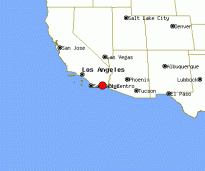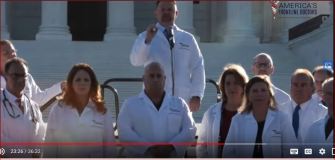.
Sat., Oct. 17, 2020, Dr. Brian Tyson was among nine physicians from America’s Frontline doctors who spoke on the Supreme Court steps on Saturday. Two of the physicians are also lawyers. Dr. Tyson was 7th speaker:
1. Dr. Simone Gold (also a lawyer), 2. Dr. James Todaro, 3. Dr. Richard
Urso, 4. Dr. Lee Merritt, 5. Dr. Jeff Mitchell (also a lawyer), 6. Dr.
Jeff Barkey, 7. Dr. Brian Tyson, 8. Dr. Robin Armstrong, 9. Dr. Mark McDonald
 Dr. Brian Tyson speaks about his experience providing early treatment for Covid near the California-Mexico border
Dr. Brian Tyson speaks about his experience providing early treatment for Covid near the California-Mexico border
Sat., Oct., 17, 2020, “Doctors speak out on misinformation surrounding the coronavirus,” You Tube
@22:28 on video, Physician #7, Dr. Brian Tyson
Image: 10/17/20, Dr. Tyson relates his 100% success rate providing early Covid treatment in high risk population
“Hello my name is Dr. Brian Tyson. I’m a board certified family medicine doctor. I have over 14 years of ER experience and hospital medicine experience. We opened up our own urgent care about two and a half years ago in the rural community of the Imperial Valley El Centro. We were at the heart of the pandemic with one of the highest risk populations in the nation due to our large Hispanic and diabetic population. We border the city of Mexicali which has 1.5 million residents. We took on the coronavirus head-on. We saw over 20,000 patients in person. We treated this virus early, we treated this virus aggressively, and we only had one hospitalization and zero deaths. [23.26]
[Image from video, Dr. Tyson emphasizes zero deaths]
Zero deaths because we were not going to stand by and allow people to die without treatment. We were told to stop testing we were told to stop prescribing but we didn’t and we continue to treat today and we’ve treated over 1900 positive patients. We’ve treated patients from 11 months old to 90 years old. We treated patients with pulse oximetry less than 90,”…
4/21/20, "Hospital Payments and the COVID-19 Death Count," Factcheck.org, Angelo Fichera
(Scroll down): "The government will pay more to hospitals for COVID-19 cases in two senses: By paying an additional 20% on top of traditional Medicare rates for COVID-19 patients during the public health emergency, and by reimbursing hospitals for treating the uninsured patients with the disease (at that enhanced Medicare rate). Both of those provisions stem from the Coronavirus Aid, Relief, and Economic Security Act, or CARES Act.
The CARES Act created the 20% add-on to be paid for Medicare patients with COVID-19. The act further created a $100 billion fund that is being used to financially assist hospitals — a “portion” of which will be “used to reimburse healthcare providers, at Medicare rates, for COVID-related treatment of the uninsured,” according to the U.S. Department of Health and Human Services."...
And: Place your bets:
5/4/20, "The coronavirus could kill 3,000 Americans per day by June 1, according to leaked projections from the Trump administration," Business Insider
"COVID-19 deaths could spike this month as lockdowns lift, according to a leaked, internal, draft projection from the Trump administration that The New York Times and Washington Post published Monday."...
.........
2/14/20, "An inside look at the debate around pandemic bonds, which have $425 million hinging on how deadly the coronavirus ends up being," Business Insider, Ben Winck
"A group of unique bondholders will either reap massive profits or lose hundreds of millions of dollars as the coronavirus outbreak escalates.
So-called "pandemic bonds" were first introduced by the World Bank in 2017 as a response to the Ebola virus. Investors holding the bonds enjoy higher-than-average interest rates, but stand to lose their cash in the event of a pandemic.
If certain criteria are met, the bonds' principal is transferred to the World Bank's Pandemic Emergency Financing Facility (PEF) to fund containment and relief efforts.
"We are leveraging our capital market expertise, our deep understanding of the health sector, our experience overcoming development challenges, and our strong relationships with donors and the insurance industry to serve the world's poorest people," Jim Yong Kim, World Bank Group's president, said in a 2017 statement, adding that the PEF can "potentially save millions of lives."
The bank issued two tranches of pandemic-linked bonds and derivatives collectively worth $425 million in 2017. Bondholders enjoyed more than two years of strong returns and little to worry about as few outbreaks came close to triggering the bonds' total default.
But the stability of the investment has suddenly been thrown into question as the deadly coronavirus spreads globally.
Triggers for the two classes of bonds
The two tranches of pandemic bonds represent different risks of contagion. The World Bank offered $225 million worth of Class A debt, which pay out 6.9% annually.
The bonds default if pandemic-related deaths reach 2,500 in a single nation with an additional 20 or more deaths confirmed in an overseas country, according to the bank's prospectus.
The Class B bonds have a lower bar for the debt to trigger and accordingly boast a higher interest rate, since holders are assuming more risk. The bonds pay 11.5% annually, but reach default after 250 deaths. The bonds' payout rate scales with the number of additional countries that experience more than 20 confirmed deaths. The World Bank issued $95 million worth of the Class B assets.
The coronavirus outbreak has so far [allegedly] killed more than 1,370 people and [allegedly] infected more than 60,000, surpassing SARS in lethality earlier this month. Still, Singapore, Thailand, Japan, and Korea are the only nations currently hosting more than 20 infected individuals.
Debate over the bonds' efficacy
While the World Bank touts the debt as an efficient way to connect financial markets with epidemic relief, others have their doubts that the bonds help ailing nations at all. The assets' lengthy prospectus hides numerous requirements that gum up any effort to release funds when they're most needed, according to Olga Jonas, senior fellow at the Harvard School of Public Health and former World Bank economist.
Funds can only be released from the PEF for non-flu epidemics 12 weeks after the "start of the event," according to a World Bank document. The novel coronavirus strains were first reported on in late December, leaving funds locked up until late March.
Even once the deadline is met, the outbreak has to cause at least 20 deaths in two or more countries to trigger the bonds. While China reached the fatality threshold weeks ago, no other nation is close, leaving the PEF frozen while the virus continues to spread.
"The advertising was that there would be early, rapid, predictable, transparent financing available for outbreaks so that they don't become pandemics," Jonas told Business Insider in an interview. "In order for that to happen you have to have early triggers. The triggers in the design are very late."
A "distraction" from "getting serious"
Jonas alleges that the World Bank didn't even need to issue bonds to better prevent pandemics. The former economist called the instruments a "distraction" from "getting serious about supporting preparedness" in developing countries. The $500 million made available through the PEF is a paltry sum compared to the tens of billions of dollars the World Bank holds in liquid assets, she added.
"The money on the table from [the World Bank's International Development Association] didn't need to transit the PEF — and it certainly should not be paying for an unnecessary, inappropriate, and ineffective risk-financing instrument," Jonas said.
She added: "If you were doing this with your own money at home, that'd be grounds for divorce."
Even in the case of the bonds being triggered, Jonas doesn't expect the funds to do much good. The PEF's insurance window covers up to $500 million through its bond and swap issuances, but allocates only as much as $196 million for coronavirus outbreaks.
Once released, 76 countries can apply to receive the pandemic relief funds, watering down the total amount sent to each country. Compared to the $10 billion China is spending on virus control today, the amounts that could be released by the PEF are "trivial," Jonas said.
The bonds would've been useful "if you are not able to finance the risk otherwise," she added. "The World Bank has excellent capacity to finance the risk otherwise.""
As the deadly outbreak of coronavirus spread around the world, and with the World Health Organization (WHO) yet to declare a pandemic, skeptics are now wondering if it’s all about the money."...
................




No comments:
Post a Comment